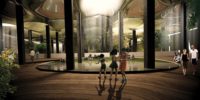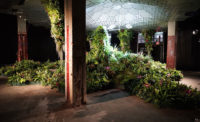New Yorkers don’t mind being underground when the surroundings are as welcoming as Rockefeller Center’s concourse or Grand Central Terminal’s Oyster Bar. But when James Ramsey and Dan Barasch announced plans for the Lowline in an abandoned trolley terminal below Manhattan’s Lower East Side, they set the underground bar even higher. That’s because they promised not just a shopping or dining destination, but a park with thousands of plants growing in Edenic profusion beneath Delancey Street.
That posed a technological challenge that Ramsey, a former NASA engineer, and Barasch, now the full-time director of the Lowline, have spent six years addressing. Their goal is to “concentrate” sunlight above ground, then send it through plastic tubes to underground diffusers that will simulate natural lighting well enough to keep plants photosynthesizing.
Will it work? The Lowline Lab, built at a cost of some $200,000, much of it raised on Kickstarter, is meant to help answer that question.
Though it is aboveground, the Lab (open to the public on weekends through March, at 140 Essex Street) is windowless, mimicking the Lowline space. But there are aspects of the Lowline it can't simulate. The Lab’s solar concentrators, made by the Korean company Sunportal and configured by RAAD Studio, a firm headed by Ramsey, are mounted on a roof just above the demonstration garden. In the case of the actual Lowline, the collectors would be mounted atop neighboring buildings; they would reflect light to street level, possibly hundreds of feet below, where tubes would direct it to the underground park.
In the Lowline Lab, more than 50 kinds of plants — chosen by Signe Nielsen of Mathews Nielsen Landscape Architects in partnership with the Brooklyn Botanic Garden and built by John Mini Distinctive Landscapes — seem to be thriving. (Among them are bromeliads and the evocatively named Baby’s Tears and Mother-in-Law's tongue.) In the Lowline, which will be as big as a football field, they will be arranged in swooping gardens, some descending from the ceiling like stalactites, others rising up like stalagmites. The idea, the park’s organizers say, is to stress the verticality of the 16-foot-high space, as well as to take advantage of varying light intensities. Ramsey says the concentrated light can reach 30 times normal intensity. Handled improperly, he says, “it would give you a wicked sunburn.”
But the Lowline organizers face more than just technical challenges. They estimate that the Lowline will cost $2 to $4 million a year to operate; they believe the money can be raised through a combination of grants, donations and facility rentals. However critics are concerned that commercial entanglements — including use of the Lowline as an event space — might limit public access.
Two years ago, the stakes got higher for the Lowline organizers. That’s when the city chose a developer for Essex Crossing, a collection of mixed-use buildings that will occupy a string of former parking lots south of Delancey Street, lots that in an appalling abuse of power had been kept empty by local politicians determined to maintain the Lower East Side’s precarious ethnic balance. The developer, a consortium called Delancey Street Associates, is prepared to spend more than $1 billion on the 1.7 million-square-foot development.
Essex Crossing’s retail component includes an underground mall adjacent to the Lowline space. As a result, Barasch says, “We will need to cooperate in some capacity.” In addition, it is likely the light concentrators would be mounted on Essex Crossing buildings, for which the developers might demand concessions. Barasch said he and Ramsey have been in talks with the Delancey Street Associates, though no agreements have been reached. Meanwhile, Goldman Sachs, which has committed $200 million in funding to Essex Crossing, helped fund the Lowline Lab.
Another hurdle: The Lowline can only become reality if the Metropolitan Transportation Authority, which controls the former trolley terminal (abandoned in 1948), agrees to transfer the space to the city. Making that happen will require political capital. Already a number of city and state officials (as well as celebrities like Lena Dunham and Spike Jones) have thrown their support behind the plan. It can’t hurt, as the Lowline organizers walk a tightrope between public benefit and commercial viability, to have a powerful ally like Goldman.


















Post a comment to this article
Report Abusive Comment